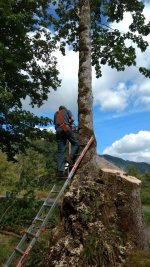lectro88
Member
- Joined
- Jan 19, 2011
- Messages
- 46
- Location
- Charlotte, NC
- Tractor
- Exmark 60" Takeuchi tb-135, Thomas skid steer, Ford 600
Hey Root Cause.
No offense taken.
my take on things is just keep it simple and when you have the bare minimum you can do just fine.
I didn’t mean to give the impression that these items didn’t work well, or well enough.
esp. with covid things can be difficult to obtain.
Then on top of that.. if some little something let’s lose, breaks or the whole thing can’t be found in the tool box.
just a plain jane straight file, or a pack(12) files can be strewn in several places, truck, basement, garage, toolbox, etc.. at a fraction of the cost of 12 special units.
Then any place you find yourself in need of a full on sharpening or a slight touch up you have it at your fingertips and you are proficient enough to pull it off in a 1/2 hr or so depending on bar length.
I don’t claim to be an expert, but with 40 yrs and full wrenching on most stuff that can be disassembled or repaired…
I probably can stand with, or ahead of many or most, take your pick on how it’s worded. Not to brag just saying. (I probably have been around a little)
ALSO:;
The saw I recommended is most likely unsafe for most users and I should have stated that in my post.
It’s really for serious professional use. It’s a monster/daddy rabbit of a saw. A
And IF you give it a chance to kick back it kicks like a mule with 120cc, so that being said,. You don’t ever give it the chance.
Hence for advanced users.
And the price tag probably keeps most from having a 3120.
the point of these posts are to help out, not cause a Rukis.
No offense taken,
None intended on my part.
here’s a few pics.
I wear a 12 boot.
this is baby bear, momma bear, and Big Bad Daddy bear.
I use my stuff but take care or it.
and they are ready when I grab one.
below is my pruning 435 at 35cc.
next is 460 /60cc that is my main go to.
it’s twice the size of 435.
then the 3120 at 120cc is twice the size of the 460.
and it’s a Beast.




No offense taken.
my take on things is just keep it simple and when you have the bare minimum you can do just fine.
I didn’t mean to give the impression that these items didn’t work well, or well enough.
esp. with covid things can be difficult to obtain.
Then on top of that.. if some little something let’s lose, breaks or the whole thing can’t be found in the tool box.
just a plain jane straight file, or a pack(12) files can be strewn in several places, truck, basement, garage, toolbox, etc.. at a fraction of the cost of 12 special units.
Then any place you find yourself in need of a full on sharpening or a slight touch up you have it at your fingertips and you are proficient enough to pull it off in a 1/2 hr or so depending on bar length.
I don’t claim to be an expert, but with 40 yrs and full wrenching on most stuff that can be disassembled or repaired…
I probably can stand with, or ahead of many or most, take your pick on how it’s worded. Not to brag just saying. (I probably have been around a little)
ALSO:;
The saw I recommended is most likely unsafe for most users and I should have stated that in my post.
It’s really for serious professional use. It’s a monster/daddy rabbit of a saw. A
And IF you give it a chance to kick back it kicks like a mule with 120cc, so that being said,. You don’t ever give it the chance.
Hence for advanced users.
And the price tag probably keeps most from having a 3120.
the point of these posts are to help out, not cause a Rukis.
No offense taken,
None intended on my part.
here’s a few pics.
I wear a 12 boot.
this is baby bear, momma bear, and Big Bad Daddy bear.
I use my stuff but take care or it.
and they are ready when I grab one.
below is my pruning 435 at 35cc.
next is 460 /60cc that is my main go to.
it’s twice the size of 435.
then the 3120 at 120cc is twice the size of the 460.
and it’s a Beast.
Last edited:
